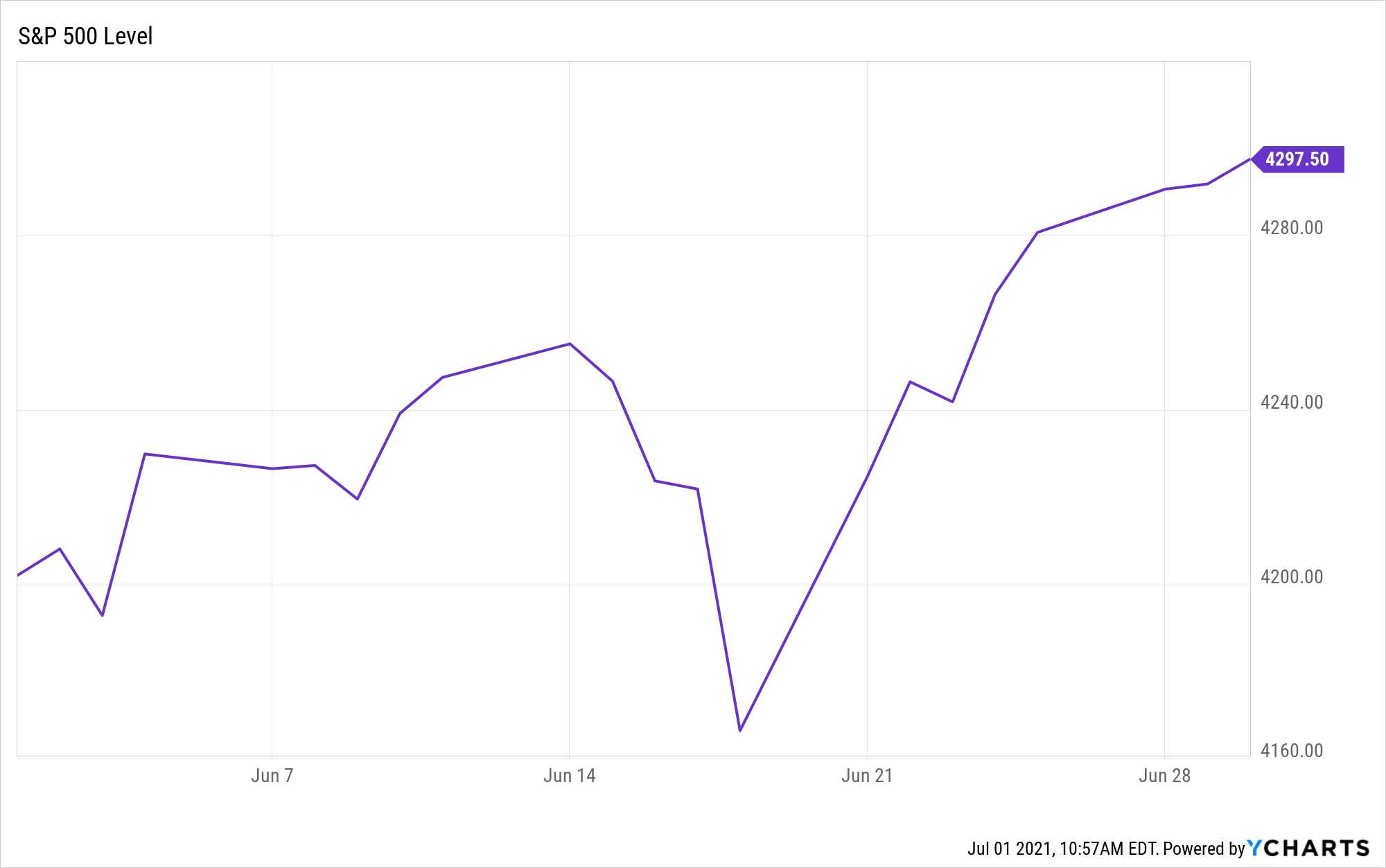Monthly Market Update
Submitted by TLWM Financial on July 1st, 2021
As June comes to a close, it’s hard to believe we are already halfway through the year; although, a lot has changed since January 1st. It is wonderful to be back in the office with the full team and to be able to meet with many of you face-to-face once again.
Stocks moved higher in June adding to a very strong first half of the year for stocks with the S&P 500 up about 14% (YCharts). The US vaccination rollout has probably been the biggest driver as the economy has opened back up, and activity is at a much more normal level than where it was 6 months ago. Here’s a quick look at some changes since the beginning of the year:
- Interest Rates: the 10-year US Treasury yield has jumped, and is now yielding about 1.5% after starting the year at 0.93%. (YCharts)
- Earnings growth: 2021 earnings growth expectations have increased: current estimates call for 34% growth as of 6.11.21, up from about 22% in mid-January. (FactSet)
- Labor Market: The labor market continues to improve: the unemployment rate has dropped to 5.8% after beginning the year at 6.3%
- Economic Dashboard: Our economic dashboard continues to look good: 5 out of 7 indicators are currently green (no warning) and 2 are yellow.
These data points suggest that the economic recovery will continue this year and into 2022; however, we believe that we may see some stock market volatility throughout the year. Volatility at this stage of a bull market would not be surprising and we feel it would likely be normal and healthy for stocks.
As we look to the rest of 2021, here are a few key factors to watch.
- The Fed - Thus far, the Fed has continued to pledge support to the economy, but Fed communication and policy could be a wild card. As the Fed starts talking about potential policy changes any communication that surprises investors could lead to volatility.
- COVID & Global Vaccinations- As the global economy continues to rebound from the pandemic shutdown it will be important to see progress in global vaccinations as this should allow restrictions to be eased further, and potentially lead to an acceleration of economic activity around the world.
- US Political Policy- We will be watching policy coming out of Washington with a particular focus on infrastructure spending and potential tax and regulatory changes.
Our outlook for stocks continues to be positive as we look out over the next 9-12 months, but we will be keeping a close eye on the items mentioned above. As such, we continue to have portfolios positioned to take advantage of the economic recovery but are ready to make tweaks as the year evolves.
Sincerely,
Your TLWM Team
*Investment advice offered through TLWM, LLC., a registered investment advisor.
*The Standard & Poor's 500 (S&P 500) is an unmanaged group of securities considered to be representative of the stock market in general. You cannot invest directly in this index.
*The Standard & Poor’s 500 (S&P 500) is an unmanaged index. Unmanaged index returns do not reflect fees, expenses, or sales charges. Index performance is not indicative of the performance of any investment.
*The 10-year Treasury Note represents debt owed by the United States Treasury to the public. Since the U.S. Government is seen as a risk-free borrower, investors use the 10-year Treasury Note as a benchmark for the long-term bond market.
*Government bonds and Treasury Bills are guaranteed by the U.S. government as to the timely payment of principal and interest and, if held to maturity, offer a fixed rate of return and fixed principal value. However, the value of fund shares is not guaranteed and will fluctuate.
*Corporate bonds are considered higher risk than government bonds but normally offer a higher yield and are subject to market, interest rate and credit risk as well as additional risks based on the quality of issuer coupon rate, price, yield, maturity, and redemption features.
*Credit risk can be a factor in situations where an investment’s performance relies on a borrower’s repayment of borrowed funds. With credit risk, an investor can experience a loss or unfavorable performance if a borrower does not repay the borrowed funds as expected or required. Investment holdings that involve forms of indebtedness (i.e. borrowed funds) are subject to credit risk.
*Typically, the values of fixed-income securities change inversely with prevailing interest rates. Therefore, a fundamental risk of fixed-income securities is interest rate risk, which is the risk that their value will generally decline as prevailing interest rates rise, which may cause your account value to likewise decrease, and vice versa. How specific fixed income securities may react to changes in interest rates will depend on the specific characteristics of each security. Fixed-income securities are also subject to credit risk, prepayment risk, valuation risk, and liquidity risk. Credit risk is the chance that a bond issuer will fail to pay interest and principal in a timely manner, or that negative perceptions of the issuer’s ability to make such payments will cause the price of a bond to decline.
*Opinions expressed are subject to change without notice and are not intended as investment advice or to predict future performance.
*Economic forecasts set forth may not develop as predicted and there can be no guarantee that strategies promoted will be successful.
*Past performance does not guarantee future results. Investing involves risk, including loss of principal.
*You cannot invest directly in an index.
*Consult your financial professional before making any investment decision.
* Stock investing involves risk including loss of principal.
*This document is solely for informational purposes. Advisory services are only offered to clients or prospective clients where Texas Legacy Wealth Management and its representatives are properly licensed or exempt from licensure.
*No strategy ensures a profit or protects against a loss.

